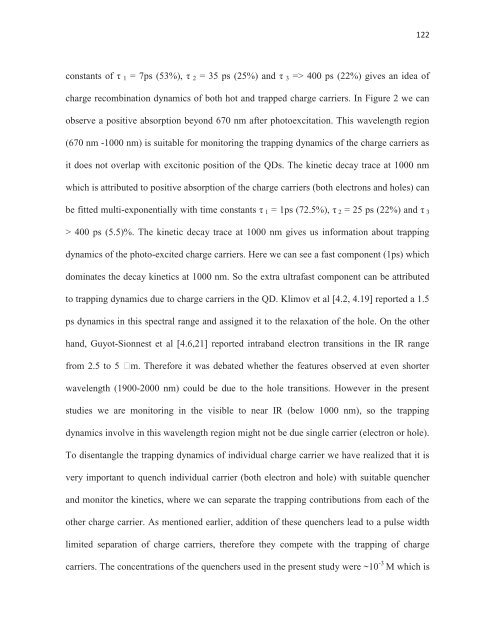CHEM01200604009 Sreejith Kaniyankandy - Homi Bhabha ...
CHEM01200604009 Sreejith Kaniyankandy - Homi Bhabha ...
CHEM01200604009 Sreejith Kaniyankandy - Homi Bhabha ...
You also want an ePaper? Increase the reach of your titles
YUMPU automatically turns print PDFs into web optimized ePapers that Google loves.
122<br />
constants of τ 1 = 7ps (53%), τ 2 = 35 ps (25%) and τ 3 => 400 ps (22%) gives an idea of<br />
charge recombination dynamics of both hot and trapped charge carriers. In Figure 2 we can<br />
observe a positive absorption beyond 670 nm after photoexcitation. This wavelength region<br />
(670 nm -1000 nm) is suitable for monitoring the trapping dynamics of the charge carriers as<br />
it does not overlap with excitonic position of the QDs. The kinetic decay trace at 1000 nm<br />
which is attributed to positive absorption of the charge carriers (both electrons and holes) can<br />
be fitted multi-exponentially with time constants τ 1 = 1ps (72.5%), τ 2 = 25 ps (22%) and τ 3<br />
> 400 ps (5.5)%. The kinetic decay trace at 1000 nm gives us information about trapping<br />
dynamics of the photo-excited charge carriers. Here we can see a fast component (1ps) which<br />
dominates the decay kinetics at 1000 nm. So the extra ultrafast component can be attributed<br />
to trapping dynamics due to charge carriers in the QD. Klimov et al [4.2, 4.19] reported a 1.5<br />
ps dynamics in this spectral range and assigned it to the relaxation of the hole. On the other<br />
hand, Guyot-Sionnest et al [4.6,21] reported intraband electron transitions in the IR range<br />
from 2.5 to 5 m. Therefore it was debated whether the features observed at even shorter<br />
wavelength (1900-2000 nm) could be due to the hole transitions. However in the present<br />
studies we are monitoring in the visible to near IR (below 1000 nm), so the trapping<br />
dynamics involve in this wavelength region might not be due single carrier (electron or hole).<br />
To disentangle the trapping dynamics of individual charge carrier we have realized that it is<br />
very important to quench individual carrier (both electron and hole) with suitable quencher<br />
and monitor the kinetics, where we can separate the trapping contributions from each of the<br />
other charge carrier. As mentioned earlier, addition of these quenchers lead to a pulse width<br />
limited separation of charge carriers, therefore they compete with the trapping of charge<br />
carriers. The concentrations of the quenchers used in the present study were ~10 -3 M which is
















